cooling Oldsmobile Achieva 1998 s User Guide
[x] Cancel search | Manufacturer: OLDSMOBILE, Model Year: 1998, Model line: Achieva, Model: Oldsmobile Achieva 1998Pages: 356, PDF Size: 18.04 MB
Page 209 of 356
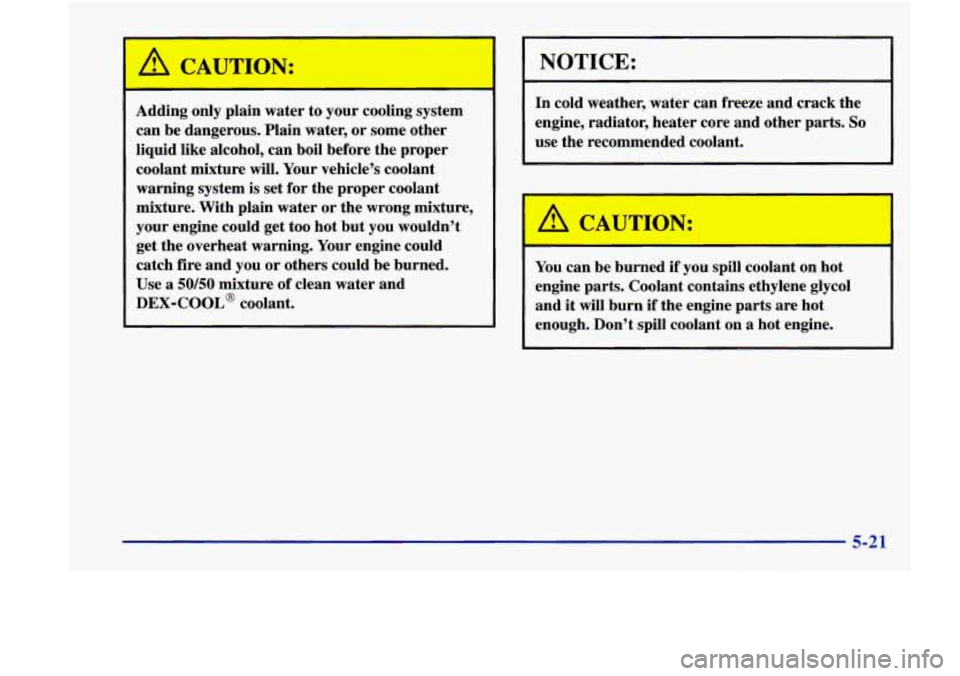
A CAUTION:
Adding only plain water to your cooling system
can be dangerous. Plain
water, or some other
liquid like alcohol, can boil before the proper
coolant mixture will. Your vehicle’s coolant
warning system is set for the proper coolant
mixture. With plain water or the wrong mixture,
your engine could get too hot but you wouldn’t
get the overheat warning. Your engine could
catch fire and you or others could be burned.
Use
a 50/50 mixture of clean water and
DEX-COOL@ coolant.
I NOTICE:
In cold weather, water can freeze and crack the
engine, radiator, heater core and other parts.
So
use the recommended coolant.
A CAUTION:
~
You can be burned if you spill coolant on hot
engine parts. Coolant contains ethylene glycol
and it will burn
if the engine parts are hot
enough. Don’t spill coolant on a hot engine.
5-21
Page 210 of 356
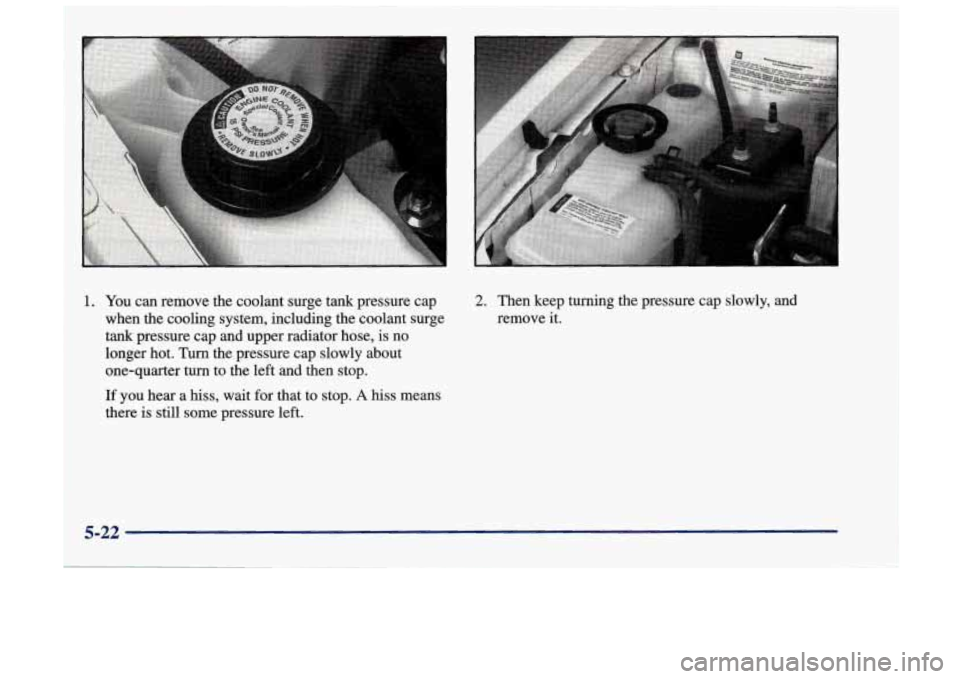
1. You can remove the coolant surge tank pressure cap
when the cooling system, including the coolant surge
tank pressure cap and upper radiator hose, is no
longer hot. Turn the pressure cap slowly about
one-quarter turn to the left and then stop.
If you hear a hiss, wait for that to stop. A hiss means
there is still some pressure left.
5-22
Page 211 of 356
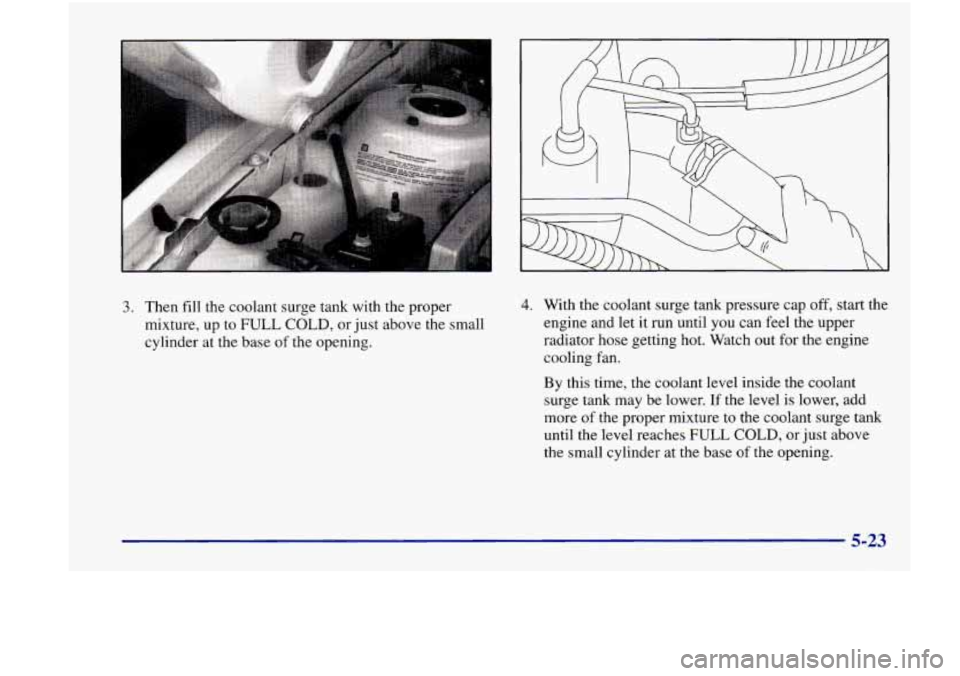
3. Then fill the coolant surge tank with the proper
mixture, up
to FULL COLD, or just above the small
cylinder at the base
of the opening.
4. With the coolant surge tank pressure cap off, start the
engine and let it run until you can feel the upper
radiator hose getting hot. Watch out for the engine
cooling fan.
By this time, the coolant level inside the coolant
surge tank may be lower.
If the level is lower, add
more
of the proper mixture to the coolant surge tank
until the level reaches
FULL COLD, or just above
the small cylinder at the base of the opening.
5-23
Page 212 of 356

5. Then replace the pressure cap. Be sure the pressure
Check the level in the surge tank when the cooling
system has cooled down. If the coolant isn’t at the
proper level, repeat Steps
1 to 3 and reinstall the
pressure cap or
see your retailer.
cap
is tight.
If a Tire Goes Flat
It’s
unusual for a tire to “blow out” while you’re driving,
especially if you maintain your tires properly. If
air goes
out of a tire, it’s much more likely to leak out slowly.
But
if you should ever have a “blowout,” here are a few
tips about what to expect and what to do:
If a front tire fails, the flat tire will create a drag that
pulls the vehicle toward that side. Take your foot off the
accelerator pedal and grip the steering wheel firmly.
Steer to maintain lane position, and then gently brake to
a stop well out of the traffic lane.
A rear blowout, particularly on a curve, acts much like a
skid and may require the same correction you’d use in a
skid. In any rear blowout, remove your foot from the
accelerator pedal. Get the vehicle under control by
steering the way you want the vehicle to go. It may be
very bumpy and noisy, but you can still steer. Gently
brake to a stop
-- well off the road if possible.
If a tire goes flat, the next part shows how to use your
jacking equipment to change a flat tire safely.
5-24
Page 249 of 356
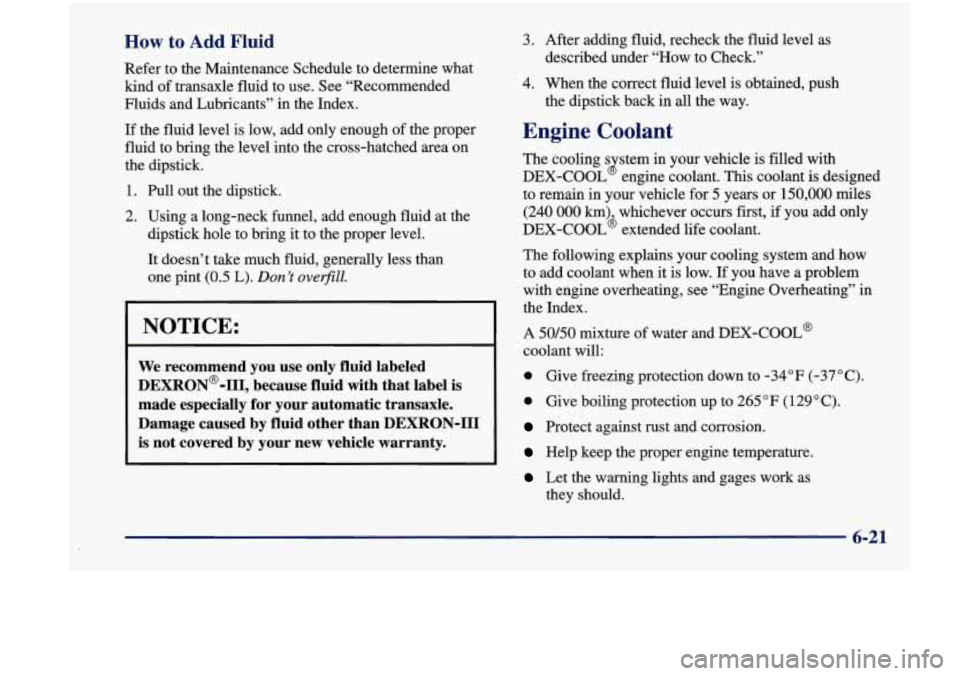
How to Add Fluid
Refer to the Maintenance Schedule to determine what
kind of transaxle fluid to use. See “Recommended
Fluids and Lubricants” in the Index.
If the fluid level is low, add only enough of the proper
fluid to bring the level into the cross-hatched area on
the dipstick.
1. Pull out the dipstick.
2. Using a long-neck hnnel, add enough fluid at the
dipstick hole to bring
it to the proper level.
3. After adding fluid, recheck the fluid level as
described under “How to Check.”
4. When the correct fluid level is obtained, push
the dipstick back in all the way.
Engine Coolant
The cooling s stem in your vehicle is filled with
DEX-COOL engine coolant.
This coolant is designed
to remain in your vehicle for 5 years or
150,000 miles
(240 000 km) whichever occurs first, if you add only
DEX-COOL’ extended life coolant.
B
It doesn’t take much fluid, generally less than The following explains your cooling system and how
one pint
(0.5 L). Don’t oveflZZ. to add coolant when it is low. If you have a problem
with engine overheating, see “Engine Overheating” in
I 3 the Index.
NOTICE: A 50/50 mixture of water and DEX-COOL@
coolant will:
We recommend you use only fluid labeled
DEXRON@-III, because fluid with that label is
made especially for your automatic transaxle.
is not covered by your new vehicle warranty.
Protect against rust and corrosion. Damage caused by fluid other than DEXRON-III
a Give boiling protection up to 265 “F (129 “C).
a Give freezing protection down to -34°F (-37°C).
Help keep the proper engine temperature. z
Let the warning lights and gages work as
they should.
6-21
Page 250 of 356
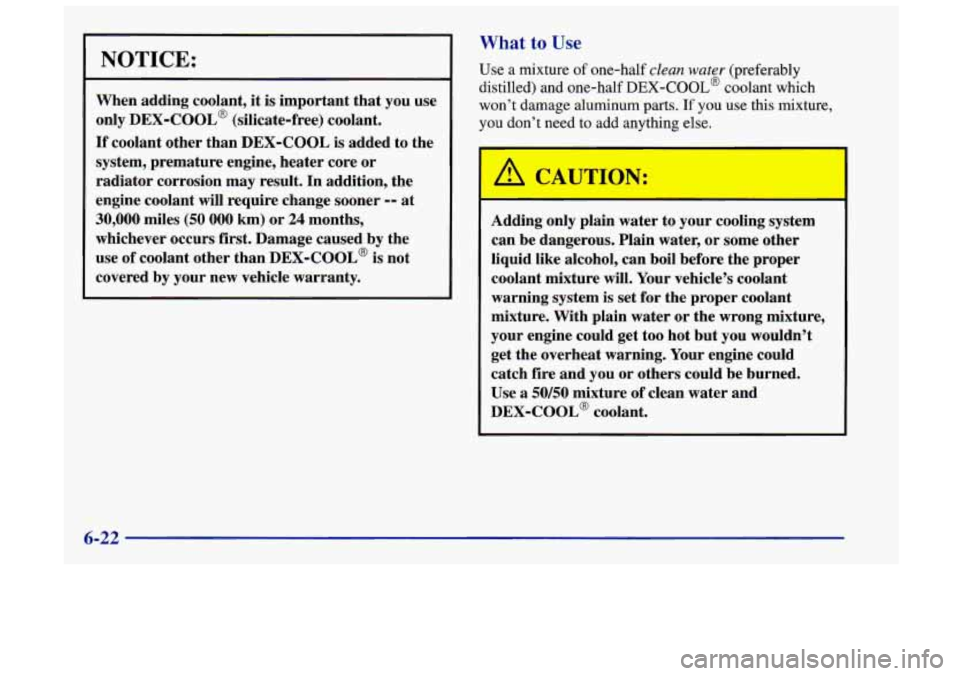
NOTICE:
When adding coolant, it is important that you use
only
DEX-COOL’ (silicate-free) coolant.
If coolant other than DEX-COOL is added to the
system, premature engine, heater core or
radiator corrosion may result. In addition, the
engine coolant will require change sooner
-- at
30,000 miles (50 000 km) or 24 months,
whichever occurs
first. Damage caused by the
use of coolant other than DEX-COOL’
is not
covered by your new vehicle warranty.
What to Use
Use a mixture of one-half clean water (preferably
distilled) and one-half
DEX-COOL@ coolant which
won’t damage aluminum parts.
If you use this mixture,
you don’t need to add anything else.
Adding only plain water to your cooling system
can be dangerous. Plain water, or some other
liquid like alcohol, can boil before the proper
coolant mixture will. Your vehicle’s coolant
warning system is set for the proper coolant
mixture, With plain water or the wrong mixture,
your engine could get too hot but you wouldn’t
get the overheat warning. Your engine could
catch fire and you or others could be burned.
Use a
50/50 mixture of clean water and
DEX-COOL@ coolant,
6-22
Page 251 of 356
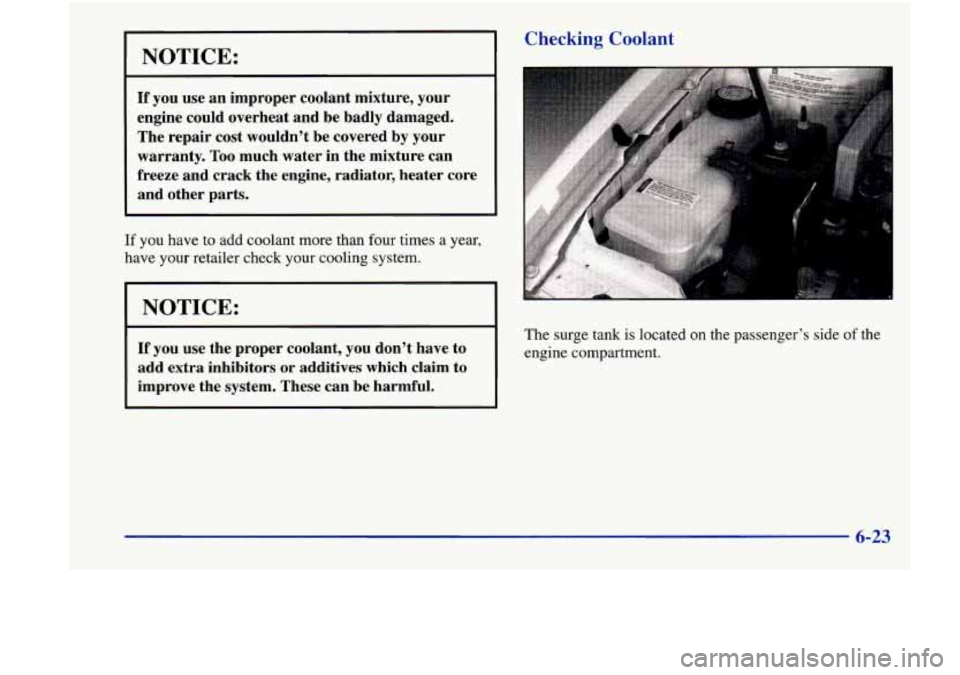
NOTICE:
If you use an improper coolant mixture, your
engine could overheat and be badly damaged.
The repair cost wouldn’t be covered by your
warranty. Too much water in the mixture can
freeze and crack the engine, radiator, heater core
and other parts.
If you have to add coolant more than four times a year,
have your retailer check your cooling system.
I NOTICE: I
If you use the proper coolant, you don’t have to
add extra inhibitors or additives which claim to
improve the system. These can be harmful.
Checking Coolant
The surge tank is located on the passenger’s side of the
engine compartment.
6-23
Page 271 of 356
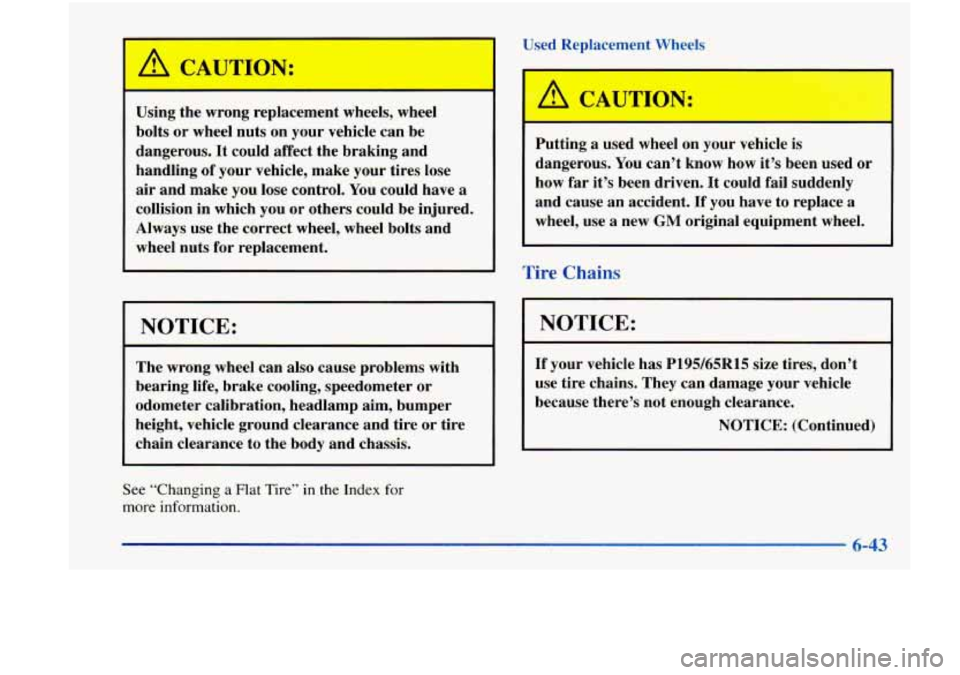
I A CAUTION:
Using the wrong replacement wheels, wheel
bolts or wheel nuts on your vehicle can be
dangerous.
It could affect the braking and
handling of your vehicle, make
your tires lose
air and make you lose control. You could have
a
collision in which you or others could be injured.
Always use the correct wheel, wheel bolts and
wheel nuts for replacement.
I NOTICE:
The wrong wheel can also cause problems with
bearing life, brake cooling, speedometer or
odometer calibration, headlamp aim, bumper
height, vehicle ground clearance and tire or tire
chain clearance to the body and chassis. Used
Replacement Wheels
Putting
a used wheel on your vehicle is
dangerous.
You can’t know how it’s been used or
how
far it’s been driven. It could fail suddenly
and cause an accident.
If you have to replace a
wheel, use a new GM original equipment wheel.
Tire Chains
I NOTICE:
If your vehicle has P195/65R15 size tires, don’t
use tire chains. They can damage your vehicle
because there’s not enough clearance.
NOTICE: (Continued)
See “Changing a Flat Tire” in the Index for
mare information.
6-43
Page 285 of 356
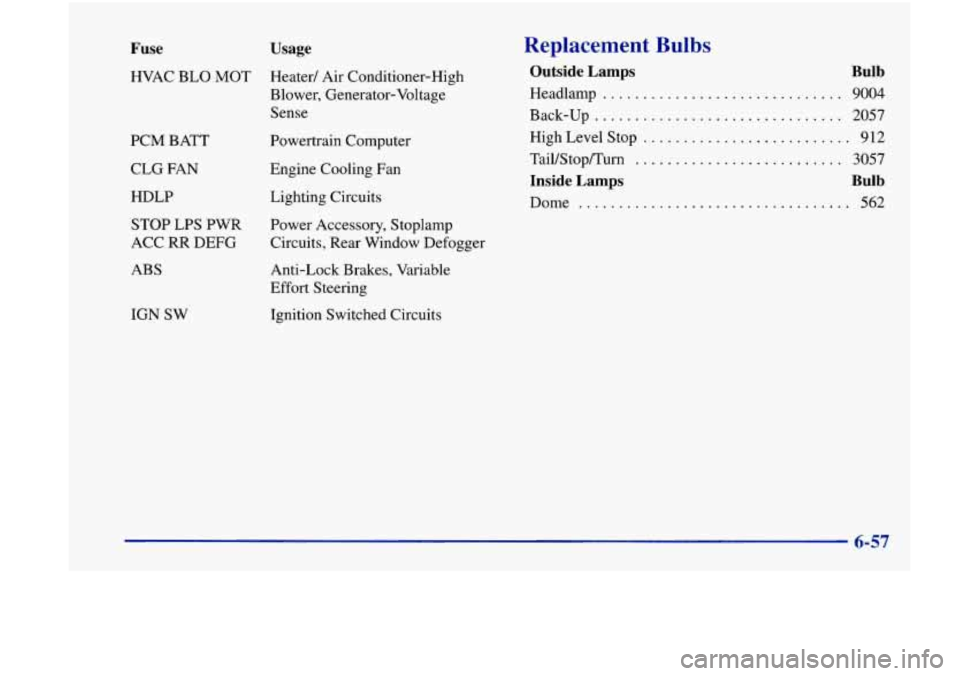
Fuse Usage
HVAC BLO MOT Heater/ Air Conditioner-High
Blower, Generator-Voltage
Sense
PCM BATT
CLG
FAN
HDLP STOP LPS PWR
ACC
RR DEFG
ABS
IGN SW Powertrain Computer
Engine Cooling Fan
Lighting Circuits
Power
Accessory, Stoplamp
Circuits, Rear Window Defogger
Anti-Lock Brakes, Variable
Effort Steering
Ignition Switched Circuits
Replacement Bulbs
Outside Lamps Bulb
Headlamp .............................. 9004
Back-up
............................... 2057
High Level Stop .......................... 912
Tail/Stop/Turn
.......................... 3057
Inside Lamps Bulb
Dome .................................. 562
Page 286 of 356
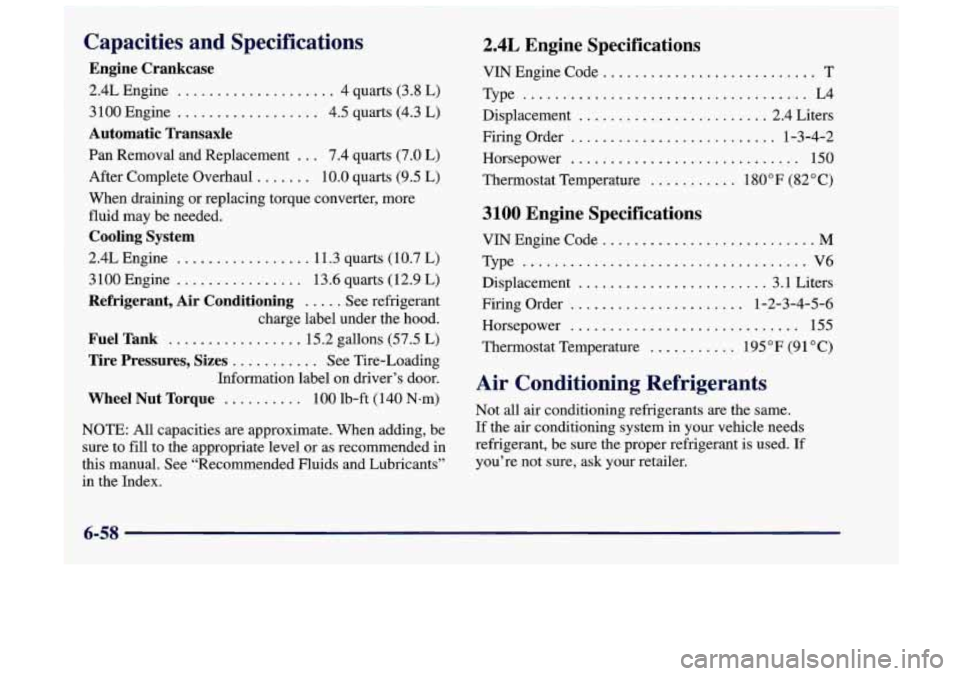
Capacities and Specifications
Engine Crankcase
2.4L Engine .................... 4 quarts (3.8 L)
3 100 Engine .................. 4.5 quarts (4.3 L)
Automatic Transaxle
Pan Removal and Replacement ... 7.4 quarts (7.0 L)
After Complete Overhaul
....... 10.0 quarts (9.5 L)
When draining or replacing torque converter, more
fluid may be needed.
Cooling System
2.4L Engine ................. 11.3 quarts (10.7 L)
3100 Engine
................ 13.6 quarts (12.9 L)
Refrigerant, Air Conditioning ..... See refrigerant
charge label under the hood.
Fuel Tank ................. 15.2 gallons (57.5 L)
Tire Pressures, Sizes ........... See Tire-Loading
Information label on driver’s door.
Wheel Nut Torque .......... 100 lb-ft (140 N-m)
NOTE: All capacities are approximate. When adding, be
sure to fill to the appropriate level or as recommended
in
this manual. See “Recommended Fluids and Lubricants”
’ in the Index.
2.4L Engine Specifications
VIN Engine Code ........................... T
Type
.................................... L4
Displacement
........................ 2.4 Liters
Firing Order
.......................... 1-3-4-2
Horsepower
............................. 150
Thermostat Temperature
........... 1 80” F (82 O C)
3100 Engine Specifications
VIN Engine Code ........................... M
Type .................................... V6
Displacement ........................ 3.1 Liters
Firing Order
...................... 1-2-3-4-5-6
Thermostat Temperature
........... 195 O F (9 1 O C)
Horsepower
............................. 155
Air Conditioning Refrigerants
Not
all air conditioning refrigerants are the same.
If the air conditioning system in your vehicle needs
refrigerant, be sure the proper refrigerant is used.
If
you’re not sure, ask your retailer.